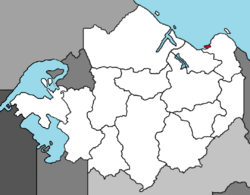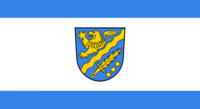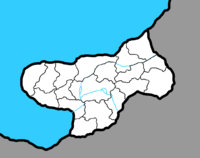Laitstadt
Laitstadt | |
|---|---|
Clockwise, from top: Laitstadt skyline, Nortua Tower, Laitstadt World Centre, Olympic Stadium of Laitstadt, Traisenbach Palace, Federal Chamber, Martin Beiter Tower | |
| Nickname(s): L-Stadt, City of Freedom | |
 Location of Laitstadt in Besmenia | |
| Country | Besmenia |
| State | Laitstadt |
| District | Districts
|
| Government | |
| • Mayor | Michael Faustmann (SDU) |
| Area | |
| • Total | 503 sq mi (1,304 km2) |
| Population (2021) | |
| • Total | 5,550,627 |
| Website | laitstadt |
Laitstadt is the capital of Besmenia and with a population of 5,550,627 millions the largest city in the country. The city is one of the 14 federal states in Besmenia. Laitstadt borders the state of Metakumburg in the south and easr. The city is one of the largest cities in Nortua. The Leina river runs through the city.
Laitstadt, which was founded in 1708, has been one of the most important centers in the Besmenian language area since the late 18th century. Laitstadt belonged to the Nortuan Union for a long time and was the capital of Heulania, an area which, in contrast to the rest of the Nortuan Union, had a very large majority of Besmenian speakers. Between February and July 1850, both sides fought in Laitstadt during the Besmenian-Tinegardian War, which destroyed about half of the city. In 1850 Laitstadt was incorporated into the Kingdom of Besmenia and remained the capital of Heulania until 1866. After the dissolution of Heulania as a result of the 1866 Besmenian territorial reform, Laitstadt became the capital of Metakumburg. In 1918, Metakumburg was one of the provinces that broke away from the Kingdom of Besmenia and formed the Confederation of East Besmenian States, along with Summingia, Gablitz, Neidenstein, Trissia and Sulzburg, with Laitstadt as the provisional seat of government. When the Federal Republic of Besmenia was founded after the Besmenian Civil War in 1920, Laitstadt became the official capital. As the federal capital, Laitstadt has developed into an important business location and metropolis of East Besmenia since the late 1920s. Since 1967, Laitstadt has been the capital of the reunified Besmenia and thus for the first time the capital of an all-Besmenian state.
Laitstadt is a world city of culture, media and politics. Many facilities such as the Bolumartin Hotel, the various universities, sports stadiums and museums have an international reputation. The city is also known for its high financial center and high quality of life.
The headquarters of the Alliance of Nortuan States are located in Laitstadt.
History
Before 1821
Kingdom of Besmenia
Captital of East Besmenia
Capital of the reunited Besmenia
With the accession of West Besmenia to the Federal Republic of Besmenia in September 1967, Laitstadt became the capital of the reunified Besmenia. Shortly after the reunification, a conflict of interest arose over the capital issue of the new reunited Besmenia. Many West Besmenians wanted Melmingen to be the capital of reunited Besmenia, as Melmingen was the capital prior to the division of Besmenia. As a result, a referendum was held in January 1968, in which voters could decide whether the seat of government should be moved to Melmingen or remain in Laitstadt. The majority voted to remain in Laitstadt.
Geography
Laitstadt is located in the southern part of the Bay of Laitstadt.
Climate
Demographics
Politics
Almost all countries on Iearth have their Besmenian embassy seat in Laitstadt, while the 13 federal states are represented by state missions. A large number of diplomatic missions are located in the Mitte district.
City state
Laitstadt seceded from Metakumburg on January 1, 1923 and has had the status of a Besmenian federal state ever since. Since then, the mayor of Laitstadt has also had the status of governor.
Economy
Infrastructure
Public transport
Laitstadt has a large network of public transport. It consists of the train lines belonging to the Besmenian Federal Railway (BBB), and the network of Laitstadt lines (S-Bahn, underground, tram and bus lines).
Sport
The most famous sports stadium is the Olympic Stadium of Laitstadt. It was built for the 1976 Olympic Games, and later also hosted the 1986 World Cup. The Olympic Stadium is a venue for international football matches between Besmenia and other countries and also for music events.








